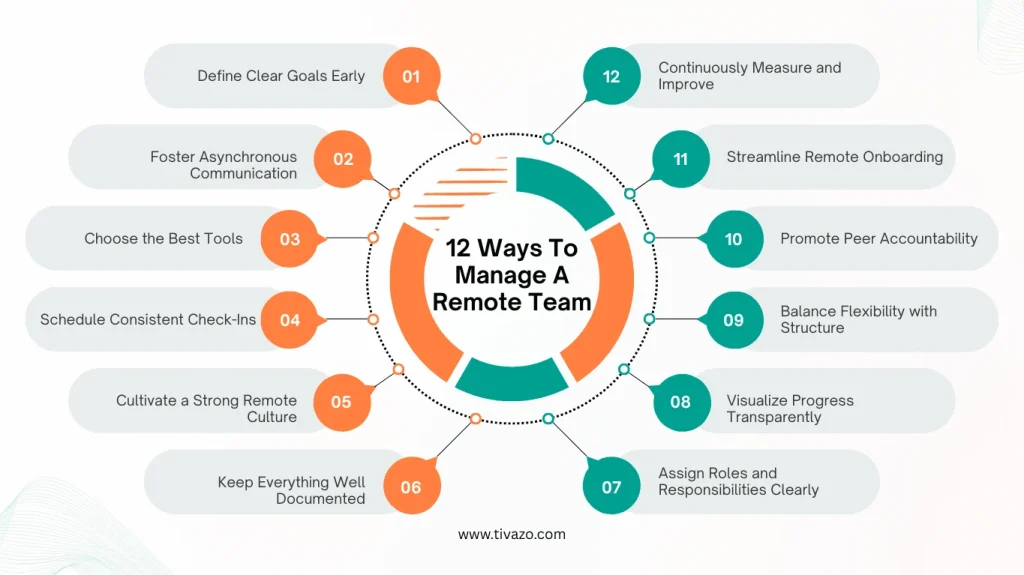Nowadays, project management for remote teams can no longer be considered an option; it is a necessity. With more enterprises using remote workforces, leaders are having new challenges when it comes to staying productive, communicating, and being accountable in different places and time zones.
Project management for remote teams has to be performed strategically, by combining clarity of goal-setting, ease of collaboration, and technology. Teams that lack these will be prone to delays and burnout.
This article covers reliable strategies on how to improve project management for remote teams so that you can never go wrong with your work, even when you are not physically present. These best practices would help organizations to increase cooperation, enhance transparency, and achieve positive project results within the remote environment.
Key Highlights:
- How To Manage A Fully Remote Team?
- How Tivazo Helps Managers In Project Management For Remote Teams?
- Different Tools For Project Management For Remote Teams
- Advantages and Disadvantages Of Remote Teams
- Metrics To Know Your Project Is Succeeding Working Remotely
What Is Project Management for Remote Teams?
Project management for remote teams is the practice of organizing, planning, and executing projects with team members working from different locations. It means organizing work, schedules, and communication using online collaboration tools, guaranteeing an efficient working process and responsibility. The main: Does project management need to change? Given the available opportunities of using cloud-based project management software and streamlined role assignments, it is possible to enhance productivity, engender trust, and produce effective results even in situations when the participants are located far away. To succeed in a flexible workforce environment, it would be important to adjust to effective remote management of team members.
How To Manage A Fully Remote Team? (12 Smart Ways)
The ability to manage remotely involved teams involves deliberate initiatives to deal with the twist of this form of work. You can implement effective strategies to improve communication and accountability and make your team stay aligned and productive no matter where they are.

1. Define Clear Goals Early
The first step for project management for remote teams is clarity. A clear and concise definition of goals, scope of the project, and deliverables at inception will give all members a clear concept of what success is all about. This convergence avoids misunderstanding and helps a team to focus on the correct priorities.
It would be transparent and keep everyone accountable to write down such goals using such collaborative project management software as Tivazo. Remote teams may become highly organised in their work across locations and time zones, providing clear goals and time scales as well as responsibility.
You May Also Like: Clear Goals for Success: 6 Key Strategies to Set for Employees
Clear guidelines also eliminate redundant movements back and forth, and the general output. Team members can perform well in project outcomes and ensure that their time is well-managed when they understand what is expected of them.
2. Foster Asynchronous Communication
Asynchronous communication becomes crucial in remote settings where time zone differences combine with flexible hours. The practice of encouraging team members to give updates without pressing to receive an answer reduces burnout and enables them to work deeply and focus.
Asynchronous messaging (Twist) and video updates (Loom) are other tools that help to keep in touch without spending time on meetings. Teams can also ensure good documentation, so that one can see it at any time and everyone can access it.
Investing in a culture in which asynchronous collaboration is not only appreciated but also actively encouraged enhances lateral output in addition to efficiency, as remote-worker employees can work at the pace that is typical of their own schedule, which makes the overall team much more productive.
3. Choose the Best Tools for Your Team
It is critical to use the appropriate project management program to simplify remote working operations. Tasks, deadlines, and progress tracking may be done on platforms such as Tivazo.
On the visual side, tools such as Lucidchart or Miro can be integrated to ensure teams brainstorm, have a visual idea of how workflows will happen, and help them stay on track. These tools facilitate clear communication and avoid the situation when misunderstandings occur frequently in the virtual environment.
You May Also Like: 10 Tips for Effective Communication in Remote Team
The right choice of a custom tool stack can make a project much more transparent and collaboration much easier, which will be instrumental in successful remote project management.
4. Schedule Consistent Check-Ins
Frequent meetings are important to stay connected and keep accountable with remote project management. Daily stand-ups, weekly team meetings, or one-on-one sessions provide the possibility to talk about the progress, difficulties, and share the priorities.
Video conferencing social tools like Zoom or Google Meet even have a human touch and create a rapport between the members of distributed teams, and foster trust. Having a face-to-face encounter with each other, even remotely, encourages bonding and gives a person a sense of community.
With an established check-in as the regular process in a project rhythm, managers create the opportunity to surface the problems early enough and keep team members involved and motivated in the project over a cycle.
5. Cultivate a Strong Remote Culture
The construction of a favorable remote working culture is essential for the engagement and productivity of teams. Gallup highlights that employees with high engagement are 21 percent more productive, and Demartini illustrates the worth of strategic cultural practices.
Such aspects as lunches together on the virtual level, shout-outs on Slack, or icebreakers at conferences can create camaraderie and help remote employees feel cared about. Such attempts establish trust and a certain level of psychological safety in the group.
A healthy culture allows open communication and collaboration and simplifies the challenges of remote project management, increasing the general morale of the team.
6. Keep Everything Well Documented
Successful remote project management lives on documentation. Documenting changes, actions, updates, and procedures keeps all the members updated and helps to minimize the possibility of miscommunication.
In the case of remote teams, the availability of documents can accelerate the process of onboarding, assist in expectations clarification, and act as a guide towards the time of project implementation. It also enhances accountability since there is a clear record of who should do what.
Maintained documentation system may be the factor that differentiates between a delay and the smoothness in a project later due to distributed teams with different working hours.
7. Assign Roles and Responsibilities Clearly
The ownership of the project should also be clear because remote teams can result in unattended initiatives. Make each task individual and lay down the criteria of success in advance.
Role clarification using models, such as RACI (Responsible, Accountable, Consulted, Informed), can facilitate roles, particularly in projects, where there are numerous stakeholders that have to be involved. This lowers duplications and mix-ups on who does what.
In responsibilities where there is clarity, there is a sense of empowering the team and responsibility to them, and this leads to increased performance and ease in delivering a project.
8. Visualize Progress Transparently
Visual project tracking tools like Kanban, Gantt Charts, and timeline provide immediate visibility on the status of a project to remote teams. Using tools such as Notion, ClickUp, or GanttPRO, one can visualize workflows, meet monthly deadlines, and bottlenecks.
It is always encouraging to see results, and this inspires other team members and enables managers to know the risks that are being incurred before they become serious. Visual transparency facilitates better decision-making and prioritizing as well.
Adding such visual elements as progress tracking would allow you to create an efficient remote project management tool and stay in touch with your team and project goals.
9. Balance Flexibility with Structure
Probably the greatest strength of working remotely is that it is rather flexible, yet it must be balanced properly to ensure productivity. Introduce mandatory working hours so that all people can meet and communicate in real time.
Add on top of it formal processes, regular deadlines, and templates to be able to give regular guidance without micromanaging. This autonomy enables the projects to run according to the schedules, yet it maintains balance.
The perfect combination of flexibility and structure will keep remote teams focused and achieve high-quality work in the desired period.
You May Also Like: 5 best Tips for Avoiding Micromanagement
10. Promote Peer Accountability
In remote undertakings, peer responsibility is a helpful motivator. Harvard Business Review estimates that strong performance can be increased by more than 35% when teams have strong accountability among peers.
Promote frequent synchronous and asynchronous check-ins when team members can report their achievements, their to-dos, and blockers. Transparency is promoted with the help of public dashboards, with task ownership visualized.
This method creates trust within the working groups who are not working with one another, and limits the management checks and balances, and it helps groups to regulate and work better on their own.
11. Streamline Remote Onboarding
The fact that the onboarding process should be smooth and is an important part of the long-term success is usually ignored in the direction of remote project management. A miscommunicated remote worker will be lonely and at a loss regarding expectations.
To get new employees onboarded fast, it is essential to prepare a remote onboarding kit that would be used and would contain documents like standard operating procedures (SOPs), welcome videos, properly outlined job-related roles, and scheduled intro calls.
Onboarding gets the tone right in engagement and productivity since it minimizes staff turnover and makes everybody give their full contribution on the first day of work.
12. Continuously Measure and Improve
Effective project management for remote teams basically involves continuous improvement. Run the post-mortems after significant milestones to review what worked out and what did not.
Absorb frequent feedback from your team that can help define the pain points and ways to improve the processes. Measure performance objectively using key metrics such as cycle time, burndown rate, or Net Promoter Score (NPS).
With every analysis and improvement in your method, you guarantee that the remote projects you work on will be smoother and more productive with the passage of time.
Following these 12 effective techniques, you may succeed in overcoming the most popular remote project management challenges and establish a cooperative, fruitful, and ready-to-go team. An ongoing core practice will not only enhance the successful nature of the project but also create a strong remote-working culture that leads to long-term success.
How Tivazo Helps Managers In Project Management For Remote Teams?
Tivazo is a comprehensive platform designed to support the work of remote teams and thereby the execution of projects and collaboration improvement. It is equipped with reliable functions like the ability to assign tasks, monitor the progress of tasks, and make real-time communication, all of which are focused on a convenient interface. Tivazo workload balancing, performance monitoring, and goal-setting capabilities as part of its team management functionality support managers in ensuring that projects stay on schedule, whilst employees have a clear view of what they are supposed to do so that they can achieve their responsibilities.

Planned as an asynchronous communication tool, Tivazo will help teams with members in different time zones by the use of threaded conversations and instant updates that minimize miscommunication and increase accountability. Also, the smooth proximity to both calendar applications and cloud-based storage increases its potency as a base to organize due dates and share documents, and provide transparency. The focus on building trust and productivity at Tivazo makes the company the optimal solution to teams who need to tackle the challenges of remote project management.
Other Different Tools For Project Management For Remote Teams
1. Trello
It is also one of the project management for remote teams tool. Trello relies on a straightforward, card-based labeling system of a Kanban board, and it allows off-site teams to arrange duties graphically. It assists in scripting, composing the priorities, monitoring the progress, and real-time collaboration. Trello can be easily integrated with other applications, and thus is the pliable choice for organizing workflow through distributed teams.
You May Also Like: 1 Among the best employee monitoring tools for free
What You May Like:
- Intuitive drag-and-drop interface ideal for visual project tracking
- Real-time collaboration with comments, attachments, and notifications
- Integrates with popular tools like Slack, Google Drive, and Jira
- Free tier available with essential features for small remote teams
What You May Not Like:
- Limited advanced reporting and analytics features
- May become cluttered with large projects or many cards
- Less suited for complex workflows or resource management
2. Asana
Asana is best at enabling remote teams to plan and monitor tasks using task lists, schedules, and automation policies. It enhances control and transparency of the projects since responsibilities and due dates are clearly assigned. Asana is appropriate in remote project management settings since it has features that support asynchronous updates.
What You May Like:
- Robust task management with subtasks, dependencies, and due dates
- Customizable project views: list, board, calendar, and timeline
- Supports automation rules to reduce repetitive work
- Strong integrations with communication tools like Microsoft Teams and Slack
What You May Not Like:
- Steeper learning curve for new users unfamiliar with remote project management software
- Some advanced features require premium plans
- Notification settings can be overwhelming if not managed properly
3. Monday
Monday.com has workflows, which can be customized to meet the needs of remote teams. It is a project tracking/communication combination with the ability to collaborate and monitor progress efficiently. It has visual dashboards and the capability of automation in making better decisions in managing virtual teams.
What You May Like:
- Highly flexible, with customizable templates and automation
- Visual dashboards that provide real-time insights into project status
- Built-in communication features to reduce tool-switching
- Scalable for small teams to large enterprises
What You May Not Like:
- Can be expensive compared to other tools at scale
- Complexity may overwhelm users new to remote project management platforms
- The mobile app has limited functionality compared to the desktop
4. Jira
Jira is a famous tool of software development teams that follow an agile approach. It assists remote teams in navigating sprints, backlogs, and a bug tracker with comprehensive reporting capabilities and collaboration functions. Jira supports project transparency and accountability in extreme project workflows.
What You May Like:
- Powerful agile project management for remote teams features, like Scrum and Kanban boards
- Detailed reporting tools for tracking velocity, burndown, and cycle time
- Extensive integration options, including Confluence and Bitbucket
- Highly customizable workflows to fit complex project needs
What You May Not Like:
- The interface can be complex and intimidating for non-technical users
- Setup and customization require time and expertise
- It may be overkill for non-software or smaller remote teams
Advantages and Disadvantages Of Remote Teams
| Advantages of Remote Teams | Disadvantages of Remote Teams |
| Increased flexibility boosts employee satisfaction and productivity. | Communication challenges are due to time zone differences and a lack of face-to-face interaction. |
| Access to a wider talent pool, unrestricted by geography. | Potential feelings of isolation and reduced team cohesion. |
| Reduced overhead costs for office space and commuting. | Difficulty in monitoring progress and maintaining accountability without direct supervision. |
| Use of digital collaboration tools enhances workflow efficiency. | Risk of miscommunication due to reliance on asynchronous communication methods. |
| Enables better work-life balance, reducing burnout. | Onboarding and training new remote hires can be more complex and time-consuming. |
Metrics To Know Your Project Is Succeeding Working Remotely
1. Track Project Progress and Completion Rate
Watching progress in the task completion and milestones can also assist in scheduling your remote project management. Overall, progress checking and detecting delays at early stages is made convenient by such visual tools as Kanban boards and Gantt charts.
2. Measure Team Productivity
The productivity should be measured in terms of quality output, turnaround time, and meeting deadlines. This discloses how effective your remote workers are in the management of workloads and across-the-board efficiency.
You May Also Like: 13 Best Remote Work Websites for Freelancers
3. Evaluate Communication Effectiveness
To be able to find gaps in collaboration, track the response time in the asynchronous communication channel, and the involvement in virtual meetings. Communication is the key to successful remote project management.
4. Monitor Team Satisfaction and Engagement

Seek feedback either during a survey or check-in at regular intervals to determine how the team feels and their level of motivation. The stronger the engagement is, the more positive the project outcomes and the lower the burnout is in the distant environment.
With the help of these metrics, project managers will be able to streamline their work process and be accountable, which will allow them to achieve success when working with project management for remote teams.
Conclusion
The future of work is not just remote, it’s smarter. Teams that adopt thoughtful, scalable remote project management practices will outpace the competition.
By applying these 12 strategies, you’ll build a culture of trust, improve execution, and help your remote team thrive.
Ready to take your project management for remote teams to the next level? Start by picking 2-3 of the above tactics and implementing them this week.
Stay agile, stay connected—and lead with clarity, no matter where your team works.
FAQ’s
What is 90% of a project manager's job?
Around 90% of a project manager’s job involves communication—sharing updates, aligning goals, resolving issues, and keeping stakeholders informed. Clear, consistent communication is crucial for remote teams to stay productive and on track.
What is the role of digital and remote teams in project management?
Digital and remote teams enable flexible, location-independent project execution. Their role includes leveraging technology to collaborate, share progress, and deliver outcomes efficiently, often across time zones and geographies.
What is a virtual project manager?
A virtual project manager leads and coordinates projects remotely using digital tools. They oversee planning, task management, team communication, and delivery—without needing to be physically present with the team.
How do you manage productivity for remote workers?
Productivity is managed by setting clear expectations, using task tracking tools, encouraging asynchronous updates, and regularly checking in. Transparency, accountability, and the right project management software are key to maintaining high performance




